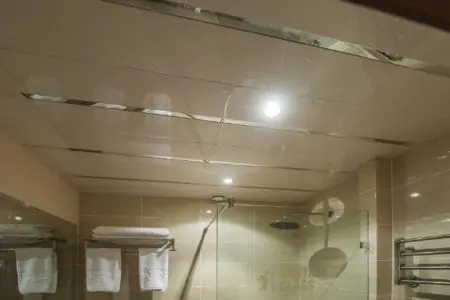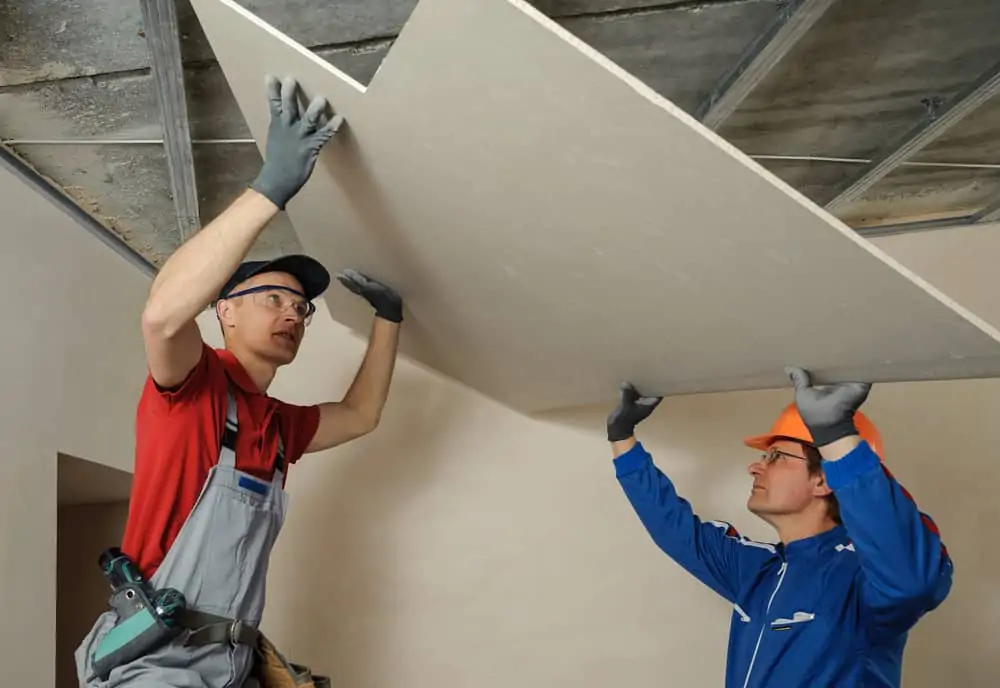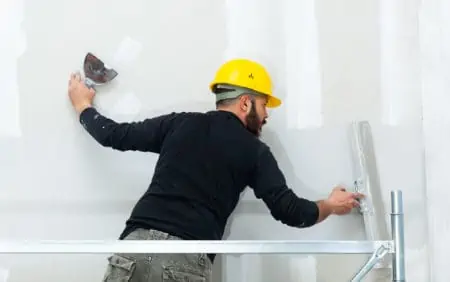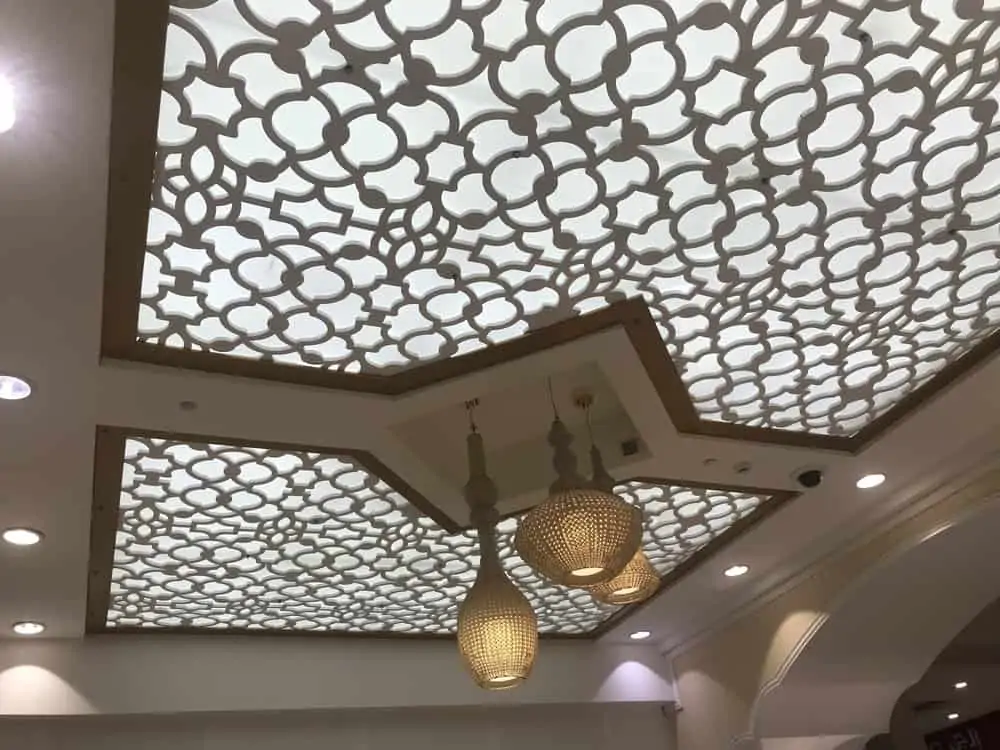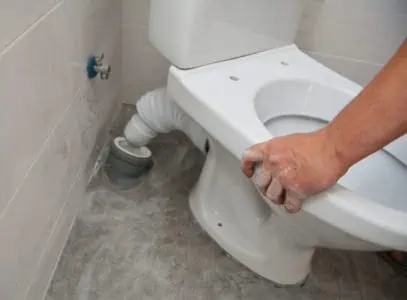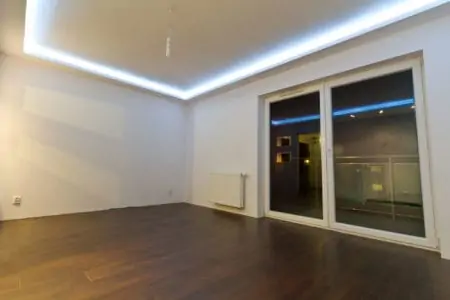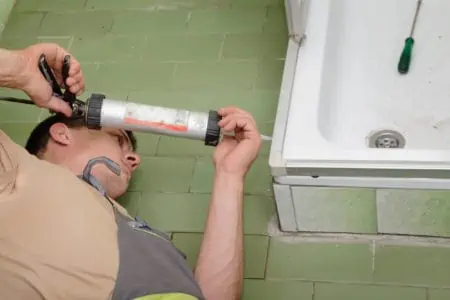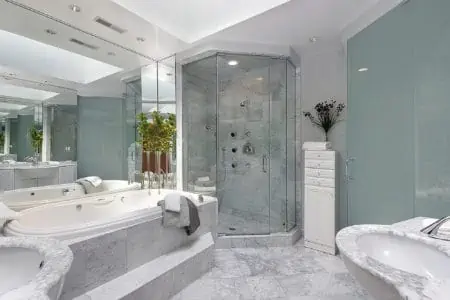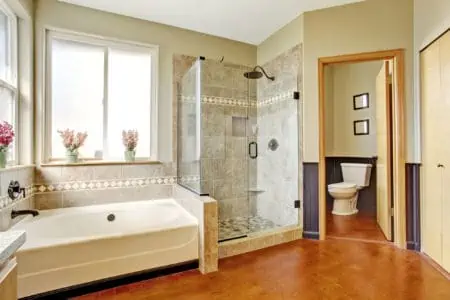When it comes to remodeling your bathroom, the materials you use should be suitable for a humid and high-moisture environment. Mold and mildew are a problem, meaning the bathroom ceiling material needs to combat fungal growth.
We run through your bathroom ceiling options to bring you 15 different materials to keep your bathroom looking good.
Key Takeaways
- Choose moisture-resistant materials. Fiberglass, PVC panels, and cement boards are great options for combating mold and mildew growth in humid bathrooms.
- Consider style and budget. From industrial metal panels to budget-friendly acrylic, there’s a bathroom ceiling material to suit every taste and budget.
- Ensure proper ventilation. Good ventilation helps reduce moisture and prevents fungal growth, making it a crucial factor in bathroom ceiling materials.
- Don’t forget maintenance. Some materials, like painted plaster, may require more maintenance, while others, like fiberglass, are easier to clean and maintain.
Factors To Consider for The Best Bathroom Ceiling
With so many choices spanning all tastes and budgets available, choosing the best bathroom ceiling material can be challenging. You need to consider the climate, the moisture content of the bathroom, and the style you want to achieve.
Before you begin your project, consult the National Kitchen and Bath Association, which states that the minimum height of your bathroom ceiling should be 80 inches. This is because when choosing a shower ceiling option, the showerhead is set at a height that is close to the ceiling. Finding a material that withstands water splashes is therefore crucial.
Climate
Bathrooms are damp environments, and mold and mildew take hold easily if left unchecked. Once it spreads, it can be a real pain getting rid of it. For wet areas like over the shower, cement board is an excellent product if you are tiling.
Using untreated drywall disintegrates as water seeps through tile grout, whereas cement board holds its shape. Moisture is your biggest enemy because it creates the perfect environment for fungal growth, so getting good ventilation is another crucial factor to consider.
Fiberglass is also a cheap and effective material to use for bathroom ceilings and one of the most popular choices in American homes. It repels water and helps to stop mold spores from taking hold.
Durability
Steam, moisture, and humidity attack your bathroom ceiling, especially as heat rises. The material you use should be durable enough to withstand the challenge. PVC paneling is an entirely waterproof material and is excellent at repelling moisture.
There are plenty of durable materials to use on your bathroom ceiling. Fiberglass, acrylic, gloss paint, and even metal are all examples of robust ceiling materials that cope with the rigors of bathroom life admirably.
Style
The style of your bathroom is a matter of personal taste. Whether you are looking to create a traditional bathroom or an ultra-modern decor scheme, there is a bathroom ceiling material to suit.
From the industrial metal look to acrylics, glass, and even aluminum composite panels, getting the ceiling right frames the room and gives you the finish you need.
Cost of The Material
The budget for your bathroom ceiling remodel dictates the type of ceiling you choose. If the costs are restrictive, you might want to look at cheaper options like fiberglass, but if money is no object, metal, glass, and even copper ceilings will transform the look of your room.
You should also consider the ease of installation as part of the overall cost. Are you choosing a material that you can DIY-install, or will it require the services of a professional?
Luckily, most ceiling materials come in large sheets, and all they require is precision when it comes to the measurements. Most can be installed using screws or glue, making it possible for the average DIY enthusiast to complete the task.
15 Bathroom Ceiling Material Ideas
From copper to aluminum and PVC to fiberglass, there are several bathroom ceiling options to choose from. Some are excellent budget ideas, while others offer a more luxurious feel to your space but are reflected in the cost.
1. Fiberglass
Fiberglass is a popular choice in American homes because it is cheap, readily available, and easy to install. It also gives you excellent protection against moisture and mold growth.
It can be purchased in pre-cut sheets, so it slots right into place, and you can even use it to line your shower stall for matching walls and ceiling. Fiberglass is the perfect material for those with limited DIY skills because you can cut it to size on-site.
Keep In Mind
Fiberglass is only water-resistant and not waterproof, so while it will repel moisture, it might need sealing to keep water at bay.
2. Polystyrene Ceiling Tiles
You don’t see polystyrene tiles much these days, but those of a certain age will remember them. They are suitable for ceilings that are uneven and in poor condition. They glue directly to almost any surface, making them super-convenient, and they cover a multitude of imperfections.
Polystyrene has fallen out of fashion with most people even though it offers insulating qualities and can be painted to any color.
Caution
Polystyrene is a significant fire risk, which is one reason why its use has declined.
3. Ceiling Tiles
Mounting tiles on the ceiling may sound unconventional, but tiles are waterproof, reduce sounds, and insulate the bathroom. You can create intricate designs, making a statement with your bathroom ceiling by letting your imagination run riot.
FYI
Grout absorbs moisture, so you might get some seepage behind the tiles. This can lead to the tiles falling when the glue fails.
Also, getting tiles to stick to the ceiling is challenging because gravity plays a role, so you need patience and the strongest tile adhesive.
4. Metal Panels
Metal panels offer that urban, industrial look. You can go for a highly polished appearance or allow the moisture to react with the metal to create a trendy rusted texture. The great news is you can get metal panels in copper, aluminum, steel, chrome, brass, and galvanized iron.
Installing metal panels will require heavy-duty fixings, so you will need to locate the wooden ceiling joists, making it more complicated than other ceiling materials.
Important
Make sure you have a ceiling that can take the extra weight because metal panels are heavier than other materials like fiberglass and PVC.
However, because they come in panels, you can remove the damaged strip and replace it with a new one instead of replacing the entire ceiling if you need to perform repairs.
5. Paint
Paint is one of the easiest materials to use to decorate your bathroom ceiling. However, different paint has varying moisture-resistant qualities.
Matte paint is better for hiding ceiling imperfections as it dries to a flat appearance that absorbs light rather than reflecting it. It also dries faster, so you can get two coats down to complete the task quicker.
Gloss paint is better for high-moisture areas of the bathroom because they contain binders and polymer resins that help the paint dry to a hard, water-resistant shell. However, gloss paint will show every imperfection on your ceiling because it reflects light.
If you don’t mind a bathroom ceiling treatment that needs frequent maintenance and is susceptible to fungal growth, then painting is a cheap and easily accessible option. However, you can buy anti-mold paint that contains a fungal inhibitor to reduce the spread of mold spores, like this Rust-Oleum Mold Killing primer.
6. Acrylic
Acrylic is increasing in popularity because it is inexpensive and comes in several colors, finishes, textures, and thicknesses. It is lightweight, easy to install, and easy to keep clean.
Acrylic also repels moisture and restricts mold growth, and when you need to perform a repair, it comes down in panels, so you only need to replace the damaged acrylic strip. The other plus with acrylic is you can embellish it with LED lights to create mood lighting.
7. Drywall (Greenwall)
Drywall is great for use in bathroom ceilings because it is easy to install and relatively inexpensive as a building material. While drywall is not water-resistant, you can cover it with water-resistant paint such as gloss or satin sheen.
Remember
If drywall gets wet, the plaster inside turns to mush, which compromises the integrity of your ceiling.
The secret is to use it underneath a waterproof surface to protect it from moisture damage.
8. Cement Board
https://sensibledigs.com/how-much-does-drywall-cost/If you want a bathroom ceiling material that resists water damage, cement board is a better choice than drywall. It handles moisture well and keeps its shape, even when it makes contact with water.
If you install tiles, cement board is a good material because it stops mold from taking hold even if water gets through. Cement board is more expensive than drywall, but the increased cost is well worth it.
Cement board is also suitable for use above the dampest areas in the bathroom, like the shower stall and bathtub. However, keep in mind that water passes straight through the cement board, so it is advisable to lay a plastic membrane down before installing.
9. Paneling
Paneling used to be all the rage, but it fell out of fashion. It was an excellent option for hiding imperfect ceilings because it went up in long panels. It is still used today, but it is nowhere near as popular as it once was.
Part of the reason is it can be challenging to install. You need to create a wooden frame on the ceiling first and then fix the paneling to the frame. This is time-consuming and takes carpentry skills that not all DIY enthusiasts possess.
Two great examples of modern paneling are ACP, an aluminum composite panel that is lightweight, strong, and smooth. It consists of thermoplastic polyethylene sandwiched between two sheets of aluminum.
The other is PVC paneling, which is waterproof and makes an excellent option for high condensation bathrooms where humidity is a problem. Thanks to mold, bacteria, and fire-resistant qualities, PVC ceiling panels are a popular choice.
10. Skylight
Installing a skylight is not an obvious choice but done correctly; it is a very stylish addition to any bathroom. Glass also lightens the room, so if your bathroom is a dark and uninviting space, consider its reflective appeal.
Skylights are expensive and difficult to install, especially if you have limited DIY skills. It would be better to call in professionals rather than risk damaging your roof. They are also notoriously difficult to keep clean, so you may need a set of steps to reach or an extendable foam cleaning pad and squeegee.
11. False Glass Ceiling
If you don’t want the tricky task of installing a skylight window, you could always opt for a false glass ceiling instead. Non-crystalline glass is the most commonly used, with admixtures to make the glass opaque and non-brittle.
You can also use a drop ceiling to introduce new designs into the bathroom that really brighten the space.
12. Timber Cladding
Just like other forms of cladding, wood has lost its appeal in recent years. Many people see it as a throwback to a bygone era. Wood expands and contracts depending on the moisture content of the bathroom, so it needs protection with varnish or gloss paint. Untreated wood rots in damp conditions, leaving it susceptible to mold.
However, timber cladding can be a stylish addition to your bathroom, and it provides excellent heat retention and noise-reducing qualities.
13. Gypsum Board
Gypsum board is inexpensive, lightweight, and water-resistant, making it a suitable product to use on your bathroom ceiling. They come in long, thin sheets that are easy to cut and shape, making them the perfect antidote to uneven and cracked ceilings.
If you install a ceiling above a shower stall or bathtub, gypsum is a good option because it resists mold and mildew growth. It also retains heat well and provides excellent sound insulation.
14. Painted Plaster
Painted plaster is one of the most common bathroom ceiling materials. It is cheap to install if you do it yourself, but it requires a high degree of skill to get the plaster super smooth. For this reason, many people rely on the services of a professional plasterer, which then makes it an expensive ceiling material.
Plaster is not the best choice of material in damp locations because if the wrong paint gets used, it peels and cracks, exposing the bare plaster beneath, making it vulnerable to mold and mildew.
15. Moldings
Moldings come in all types of material, from wood to PVC and plastic, and they are excellent options for non-shower or bathtub sections of the bathroom where moisture is lower.
Avoid composite or MDF (medium-density fiberboard) in bathrooms because they are susceptible to attack from moisture and humidity. You can paint MDF, but if water penetrates, it expands the fiberboard causing it to deteriorate.
Bathroom Ceiling FAQs
Show Your Bathroom Ceiling Some Love
This list of 15 bathroom ceiling materials is only the tip of the iceberg; there are many more options you could use. The key to a successful bathroom ceiling is to choose a material that copes with humidity and high moisture levels.
After that, all you have to do is get creative and make your bathroom ceiling a talking point for friends and family.
